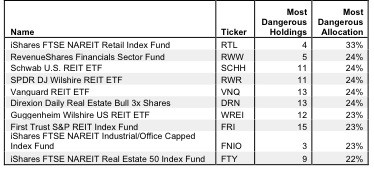My ratings on ETFs are unique because they are based on my stock ratings for each of a fund’s holdings.
Ergo, the “Most Dangerous” ETFs allocate the most capital to stocks on March’s Most Dangerous Stocks list, which was available for non-subscribers as of 3/7. There are 40 stocks on the Most Dangerous list every month.
10 Most Dangerous ETFs as of
 Sources: New Constructs, LLC and company filing
Sources: New Constructs, LLC and company filing
The figure above shows the number of Most Dangerous stocks held by the ETFs along with the percentage of the ETF’s portfolio allocated to stocks on March’s Most Dangerous Stocks list. There is a much larger range in the number of Most Dangerous stocks held by these ETFs than in the level of allocation. My series of 26 articles on the Best & Worst Funds highlights that the number of holdings in ETFs vary greatly and cannot be relied upon as an indicator of quality or lack thereof.
Naturally, most of these ETFs get my Very Dangerous fund rating because of their large allocations to stocks on the Most Dangerous list. Reports and ratings on all ETFs in the Figure above are here.
It is possible, however, for an ETF to have one of the top 10 largest allocations to stocks on the Most Dangerous stocks list and not get my Very Dangerous fund rating. This is possible only when the ETF allocates the remainder of its portfolio to enough Neutral-or-better rated stocks.
Such is the case with RevenueShares Financial Sector Fund [s: RWW], which gets my Dangerous rating. As shown in my report on RWW, it allocates over 26% of its portfolio to Neutral-or-better stocks, which earns it a Dangerous rating instead of the worst-case Very Dangerous.
For example, the largest holding in RWW is Bank of America [s: BAC], which gets my Very Dangerous rating and is a member of March’s Most Dangerous Stocks. The second largest holding is Berkshire Hathaway [s: BRK.B], which gets my Neutral rating.
Last week, I recommended investors take profits in BAC. As I wrote in “Time to unload Bank of America” and “Raising fees at BofA is a desperate move”, BAC is facing serious headwinds as a company and a stock. Regulatory restrictions have all but killed off their trading and investment banking profit centers. The company has been forced to resort to multiple accounting gimmicks (SFAS 159 and drawing down reserves by $13.3 billion) to prop up earnings while cash flows are on the decline.
At ~$8/share, the current valuation of BAC implies 20% compounded annual revenue growth for 18 years along with an improvement in ROIC from -2% to over 12% at the same time. Those expectations imply the stock is greatly overvalued. It is difficult to grow a business, especially at a high rate, when you are running off customers by raising consumer banking fees.
By comparison, BRK.B has very reasonable valuation. At ~$79/share, the current valuation implies the company will grow its after-tax cash flow (NOPAT) by 8% for five years. Over the same time, the company’s ROIC is expected to rise from 5.9% to 6.7%.
The economics of BRK.B’s business are meaningfully better than BAC as well. The company generated $826 million in free cash flow. Decent cash flows and a relatively cheap valuation earn this stock a Neutral rating.
RWW’s large allocation to BRK.B and several other Neutral-rated stocks earn the ETF a Neutral rating.
Note that Berkshire Hathaway is registered under the ticker BRK.A, not BRK.B, on my free stock screener, which provides my ratings on 3000+ stocks updated daily.
My free fund screener provides ratings and free reports on 7400+ ETFs and mutual funds, including all of the ETFs in the Figure above. All ratings are updated daily.
Disclosure: I receive no compensation to write about any specific stock, sector or theme.
2 replies to "The Most Dangerous ETFs For March"
This was a statement made in a piece I found on MarketWatch: The largest holdings typically represent only a small fraction of the overall portfolio.
Do you have any clue about how many ETFs there are where just one, two or three stocks combine for 20-40% or more of the ETF’s weight? Do you know how many ETFs devoted 50-65% of their weight to the top-10 holdings?
Clearly, you do not.
Sure. There are a few ETFs with large, concentrated holdings. And yes, those large concentrated holdings are indicative of the fund b/c they comprise so much of the fund. You make a good point. Thank you.